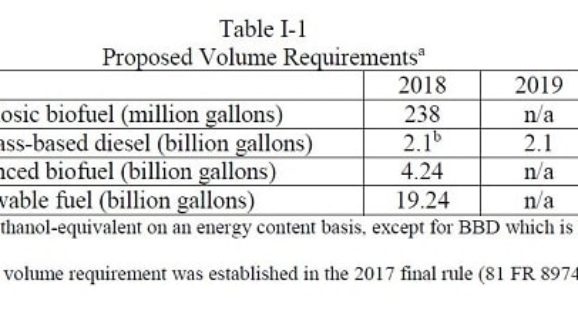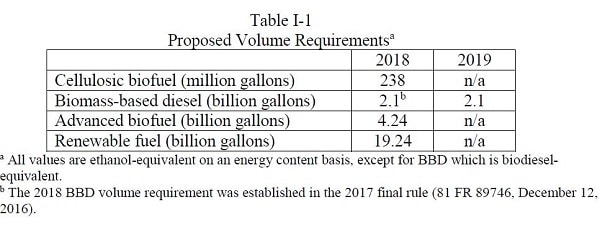EPA Proposes Renewable Fuel Standards for 2018

The Environmental Protection Agency (EPA) has released its proposed renewable fuel standards for 2018, which include the proposed biomass-based diesel standard for 2019. The so-called standards are volume obligations determining how much of the specified fuels refiners, blenders, and importers must sell in the U.S. motor fuel market, subject to certain flexibilities such as credit trading. A 45-day comment period will begin when the proposal is published in the Federal Register. The agency will finalize the rule in November.
Here are the big takeaways:
- For 2018, the EPA proposes a total renewable fuel volume of 19.24 billion gallons—a 0.2 percent reduction from the 2017 target of 19.28 billion gallons. A tiny rollback, to be sure, but if the agency sticks to its guns, this will be the first annual decrease since the program began in 2006.
- The proposed reduction occurs in the advanced biofuel category, with the cellulosic target cut from 311 million gallons in 2017 to 238 million in 2018—the actual quantity sold in 2017.
- For 2019, the EPA proposes to maintain the 2.1 billion gallon biomass-based diesel standard—the same as the 2018 target established in the agency’s final 2017 rule.
- The EPA proposes to maintain the standard for “conventional” biofuel (chiefly ethanol from corn kernels) at 15 billion gallons—the maximum obligation under the statute.
- The agency is initiating a technical analysis to “reset” the Renewable Fuel Standard statutory volumes but does not seek comment on that issue in the present rulemaking.
The proposed volume requirements are shown below:

The EPA summarizes as follows:
Relative to the levels finalized in 2017, the proposed 2018 volume requirements for advanced biofuel and total renewable fuel are lower by 40 million gallons. For the first time EPA is proposing in 2018 to reduce the advanced biofuel and total renewable fuel volumes by the same amount as we would reduce the required volume of cellulosic biofuel. These reductions effectively preserve the implied statutory volumes for conventional renewable fuel and non-cellulosic advanced biofuels, rather than requiring additional volumes of non-cellulosic advanced biofuels to backfill for some of the shortfall in cellulosic biofuel, as EPA has done in previous years. We are proposing no increase, relative to the finalized 2018 levels, in the volume requirement for biomass-based diesel for 2019.
The forthcoming reset is important because it is a confession that the gap between statutory obligations and marketplace reality is too big to be managed via ad hoc yearly adjustments.
Section 211(o)(7)(F) of the Clean Air Act requires the EPA to modify the statutory volume targets through 2022 if, starting in 2016, the agency has waived (reduced) annual volume requirements by more than 20 percent for two consecutive years or by more than 50 percent for a single year. Those thresholds have now been crossed—rather spectacularly.
The statutory cellulosic biofuel targets for 2016, 2017, and 2018 are 3 billion gallons, 4.25 billion gallons, and 5.5 billion gallons, respectively. The EPA-required volumes are tiny fractions of the statutory targets: 0.023 billion gallons in 2016, 0.031 billion gallons in 2017, and, per the current proposal, is 0.0238 billion gallons for 2018.
The same reset requirement applies to the wider category of “advanced biofuels,” of which cellulosic is a component. The statutory advanced biofuel targets for 2016, 2017, and 2018 are 7.25 billion gallons, 9 billion gallons, and 11 billion gallons, respectively. The EPA-required are 3.61 gallons in 2016, 4.28 billion gallons in 2017, and per the proposal, 4.24 billion gallons—in each case less than half the statutory targets.